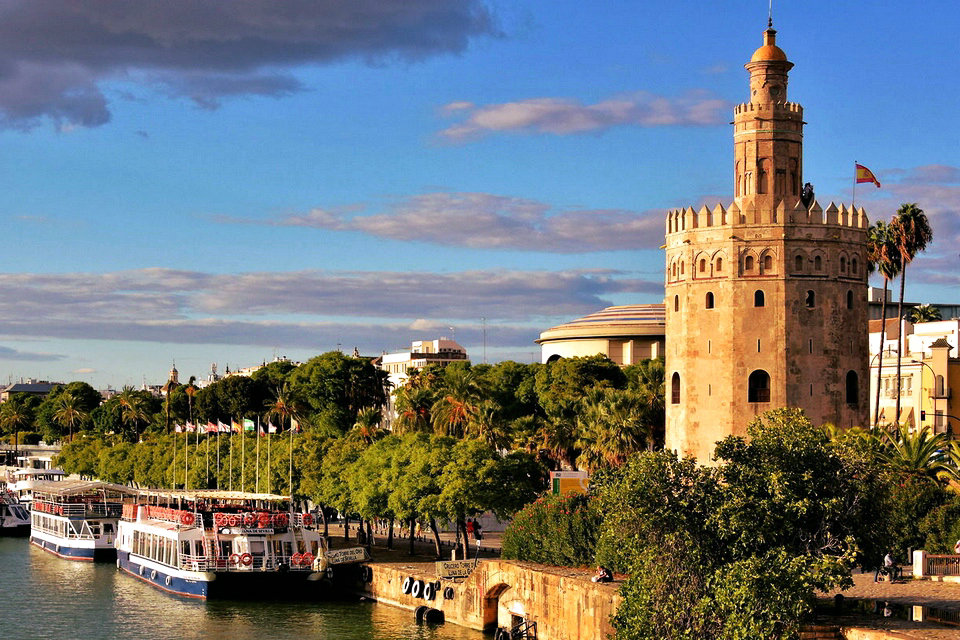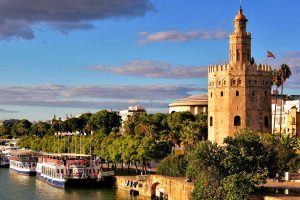The Torre del Oro Naval Museum (Seville), is located within the defensive Torre del Oro, symbol of the city, on the banks of the Guadalquivir River and next to the bullring of the Real Maestranza in Seville, Spain.
History
Before being a museum, the monument was used as a chapel, gunpowder store, port captaincy offices, prison, etc. The museum itself was created by ministerial order of March 21, 1936, being a subsidiary of the Naval Museum of the Navy, but for reasons of civil war it was inaugurated in 1944, being divided into two small plants, the lower, of 85 m², and the first, of 127 m², in total 623 m² among which all the elements shown to the visitor are distributed.
By order of the Ministry of the Navy and on the proposal of the Patronage of the Naval Museum, on March 21, 1936, the installation of the Maritime Museum was arranged in the Torre del Oro in Seville. In September 1942 the building renovation works began, in which the facade was restored and the ground and first floors were enabled as exhibition halls. The museum opened in 1944.
Content
Among its objects you can see fossilized marine debris, nautical arts mechanisms, compasses, bow masks, pictures and engravings with marine themes, ancient marine charts, historical documents… both on walls and floors.
As a summary they stand out on the ground floor: a 16th-century cannon, Renaissance style; anchors, river plans made in the 19th century, all by anonymous authors; There are also Cartuja tiles made in the 19th century and in a romantic style, the author was the merchant Marquis de Pickman (owner of the Cartuja earthenware factory ).
On the first floor: a reproduction of the first scientific world map (16th century) of Renaissance style and made by Diego Ribero; a 19th-century bow mask of classicist style; nautical flags and showcases with models of naos.
Among the showcases that contain these interesting models of ships, a steamboat of passengers, the Real Fernando, of Spanish construction that performed its first service on July 16, 1817, is especially noteworthy, another model is the Giralda yacht, in who would sail King Alfonso XIII with Don Juan de Borbón (grandfather and father respectively of King Juan Carlos I).
It also teaches a bit of the naval history of Seville, its river and the importance it had in times of the Spanish empire in the Indies and the passage left by illustrious sailors.
Exhibition
The museum comprises two visitable floors and a panoramic terrace from which to contemplate the views of Seville and its river.
On the ground floor the history of the Torre del Oro is shown, from its construction to the end of the Race of the Indies with the transfer of the Hiring House from Seville to Cádiz. One of the main pieces is the model of Real Fernando, the first steamboat built in Spain. This ship, which made its first trip from Seville to Sanlucar in 1817, led General Espartero to his exile in 1843. The copy of the engraving by Johannes Janssonius of the Seville of 1617, whose original is preserved in the Naval Museum of Madrid, also stands out.
The first floor is dedicated to the history of the Navy at various times. The tour begins at the Illustrated Marina of Antonio de Ulloa, born in Seville in 1716, as the greatest exponent of the scientific sailors of the time, accompanied by Jorge Juan and Alejandro Malaspina. The next section is dedicated to the Royal House and its relationship with Seville, where a model of the royal yacht Giralda of Alfonso XIII is displayed, accompanied by the portrait of the king with his bow mask and his flag cabinet.
The tour continues with the discovery of America and the first trip with which Columbus opened the Atlantic routes. You can see an extraordinary model of the Santa Maria caravel and a copy of the letter of Juan de la Cosa of 1500, whose original is in the Naval Museum of Madrid. The following section is dedicated to the first round the world, made between 1519 and 1522, a deed initiated by Fernando de Magallanes and completed by Juan Sebastián Elcano, whose portraits are exhibited. Finally, the visit closes with a Naval Gallery where Berlinguero and Monleón plates are exposed on vintage ships and oil paintings of notable characters.






